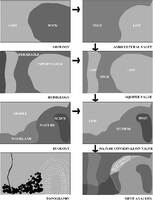- England
- Scotland
- France
- Holland
- Germany
- Italy
- Spain
- Portugal
- USA
- China
- Japan
- India
- Iran
- Advice
- Gardens
- England
- Scotland
- France
- Holland
- Germany
- Italy
- Spain
- Portugal
- USA
- China
- Japan
- India
- Iran
- Advice
- Garden Tours
Book: Landscape Planning and Environmental Impact Design: from EIA to EID
Chapter: Chapter 11 Urbanisation and growth management
Finding a good site is the hardest task. Scenically, should one chose the best land or the worst land for a major building project? It depends on the settlement type. If starting a great city, it is desirable, as instanced by Athens, Istanbul, Sydney and San Francisco, to have a spectacular site. But there are difficulties in obtaining society's agreement to new construction, especially in areas of beautiful scenery. In 1995, Britain's chief planning inspector commented that: ... if ANYBODY suggests a new settlement ANYWHERE, they can expect a ton of bricks - whether it is a logical well-supported proposal or a piece of facile opportunism. (Shepley 1995) For this reason, it is wise to conserve the 'best' land as a public good and select the 'worst' land for new construction. We can then rely on the skill of planners and designers to create good new settlements. But 'worst' and 'best' are relative terms. Sandy lowlands may be 'best' for agriculture, aquifer recharge and road construction. Rocky uplands may be 'worst' for these purposes but 'best' for scenery, recreation and nature conservation. The hard choices which have to be made should be based on a McHargian set of descriptive and evaluative maps [Fig 11.6]. They can guide decision-making but they cannot take decisions. Sometimes it will be right to build in the most beautiful places. More often, beautiful land should be conserved and new settlements placed on less important land or on land which has been degraded by human use. Since everyone's attitude to urbanisation is 'Not-In-My-Backyard', societies must resort to the democrataic process. A referendum may be necessary. 11.6 A McHargian set of sieve maps can reveal sites which are suitable for new settlements.
